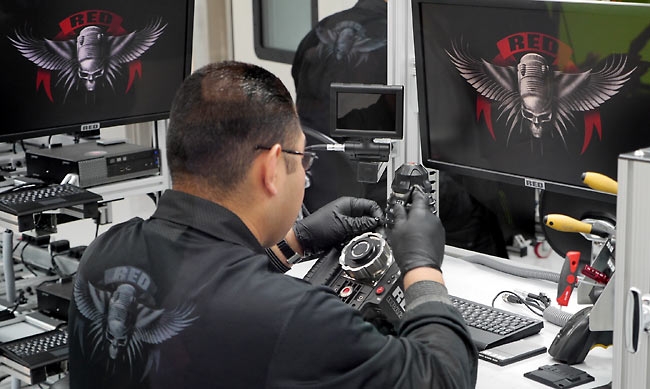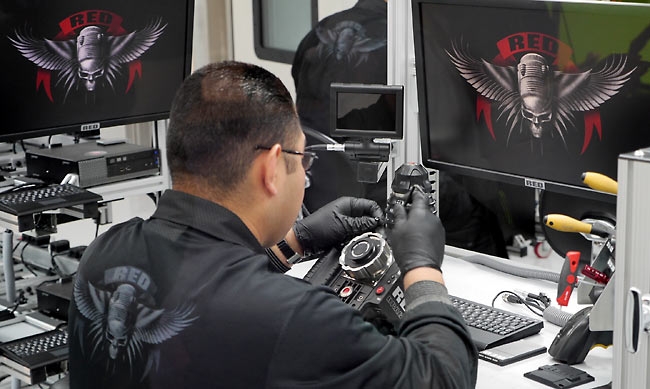
 RED NAB Clean Room
RED NAB Clean Room
A RED Tech installing a DRAGON sensor at NAB: clever theater, yes, but not the big news. Written by RedShark contributor Adam Wilt
As Freya Black points out, not everything on the RED stand at NAB got the same amount of attention. Yes, the DRAGON sensor is here: faster, sharper, better dynamic range! We’re installing ‘em here at the show! We bought Element Technica!
That’s all fine, I’m sure. Sensors should get swifter, more megapixelly magnificent, and latitudinally accommodating over time. Well done, RED, but we expected that. Installing DRAGON sensors at the show made for great theater, but make no mistake, it was theater. And E-T has been building RED kit since the early days, so there’s nothing earth-shattering about a closer (much closer) working relationship between E-T’s master machinists and the RED crew.
One bit about DRAGON got lost in all the hype of “more” (DR, resolution, ISO), and that was the talk of “new”. As RED points out.
“NEW COLOR SCIENCE ... The new RED DRAGON™ sensor features our most advanced color science yet, taking advantage of vastly improved dynamic range and low-light capabilities. Skin tones are softer, primary colors are more vibrant, and subtle color variations are discernibly remarkable.”
New Color Science
For many cinematographers this may be the single most important thing about the DRAGON. With the Mysterium and M-X chips, getting really good color, including rich and nuanced fleshtones, has been tricky. It can be done, but it often requires a bit more fiddly work in grading than is typically the case with other sensors: something I can attest to through personal experience.
If RED really has improved the color rendering of the new sensor (such that subtle color variations are not only discernibly remarkable, but remarkably discernible), it will improve the lot of DPs and colorists alike, and RED DRAGONs will be held in much higher esteesm than their predecessors. We eagerly await reports from folks in the trenches as DRAGONs start being deployed.
Going through the motion
The other big news was the “Motion Mount”: a replacement lens mount incorporating the Tessive Time Filter. The Time Filter is a temporal low-pass filter (TLPF) that reduces temporal aliasing—the harsh, edgy look of digital shuttering, backwards-spinning wagon wheels (or, nowadays, cop-car wheels on “Midsomer Murders” and “Wallander”), and the like—in a manner analogous to the way an optical low-pass filter (OLPF) reduces spatial aliasing and artifacts.
Consider that a digital camera’s sensor exposes a frame in a digital manner: it suddenly starts gathering light, then just as suddenly stops. A film camera, by contrast, has a softer exposure profile; the penumbral sweep of the mechanical shutter’s shadow across the film plane means that each exposure starts with a “sunrise” and ends with a “sunset”, instead of the now-you-see-it-now-you-don’t of a typical electronic shutter. That soft-edged exposure, and the smoothly feathered motion blur it provides, is something that digital cameras weren’t able to emulate, unless they themselves incorporated a mechanical shutter, before Tessive introduced the Time Filter at Cine Gear Expo 2011.
"...the most important advance in camera shutter technology..."
I said at the time that the Time Filter was “the most important advance in camera shutter technology since motion picture cameras were invented”, and I still feel that way. The Time Filter almost completely eliminates temporal aliasing, removing both the juddery feel of digital motion rendering and the backwards-spinning wheel phenomenon suffered by film and digital cameras alike. The Time Filter also provides variable ND capability, with or without its shuttering capability - something increasingly valuable as base ISO sensitivities climb into four digits, yet people insist on shooting shallow-depth-of-field shots in full sunlight.
So why, in the two years since Cine Gear 2011, didn’t the Time Filter come to rule the world?
For one thing, it was a bit of a beast to use: it’s an LCD filter that takes up a slot in the matte box, with a cable running to a control box. That control box modulates the transparency of the filter in sync with the camera’s exposure—meaning it needs a sync feed from the camera, or that the camera and the Time Filter needed a common reference (more cables). And, of course, it needs power (yet another cable).
For another, the Time Filter premiered at US$14,000, which was a hard sell for a filter that didn’t “do anything” except make motion look a little bit better (try pitching that to a tight-fisted producer). Over time, the price came down to just under $2000, but even so, it was difficult to convince that producer of the filter’s value.
By putting the Time Filter into a lens mount, RED has eliminated all the hassles with the original, standalone filter: no extra cables, no loss of a filter slot, no sync issues. It becomes part of the camera. Now it’s just there, and It Just Works™... or will, when it ships later this year for $4500. If you have an EPIC, just get it.
Did RED buy Tessive the way they bought Element Technica? Neither RED nor Tessive will say; Jim Jannard simply stated, “the Motion Mount uses the Tessive technology, and you will note that the Time Filter is no longer available on the market.” Indeed, the only place you’ll find it now - outside of a Motion Mount, that is - is at the five US rental houses that were prescient enough to get ‘em while they could.
More resolution is nice, and better dynamic range is always appreciated. But it’s the promise of improved color rendering and the best motion portrayal ever that gets me excited. I, for one, welcome our new EPIC DRAGON overlords... as long as they have Motion Mounts.
Adam Wilt is a self-described camera geek. When he's not shooting (stills or motion), editing, or fiddling with color, he writes software for broadcast automation, on-air graphics, and production tools for civilians, like Cine Meter.
Website URL: http://www.adamwilt.com/
Adam Wilt
Technical services: consulting / coding / camerawork
Mountain View CA USA
Tags: Technology


Comments